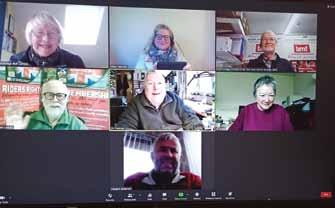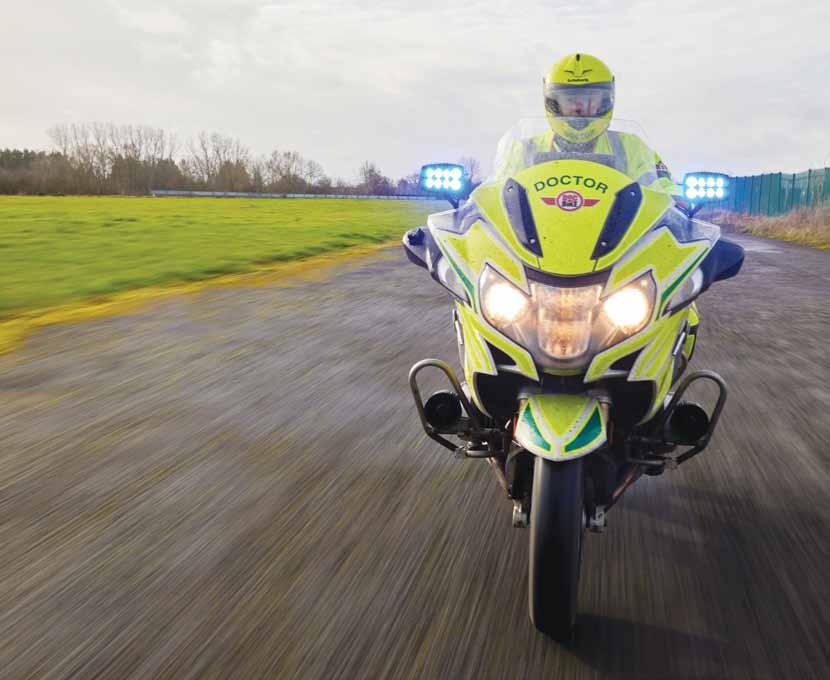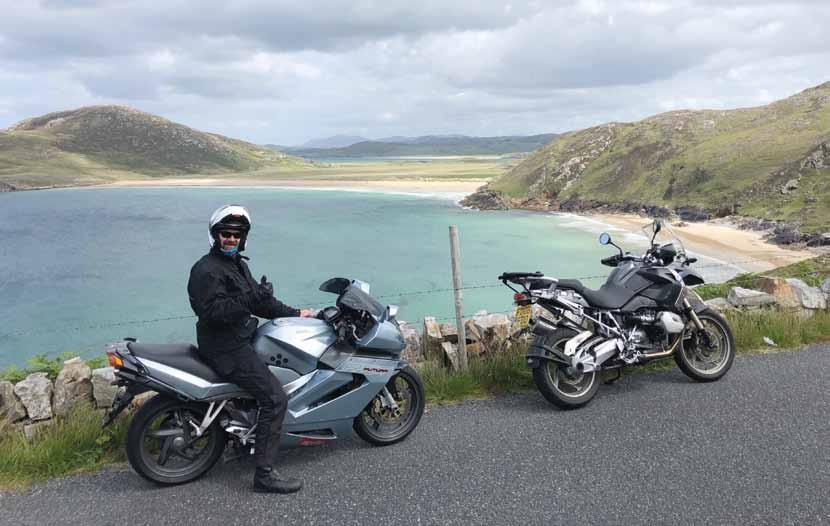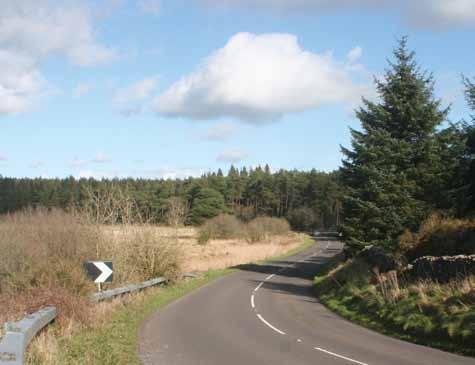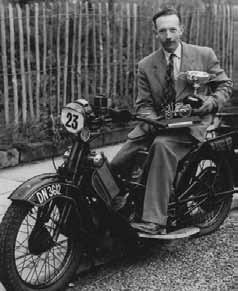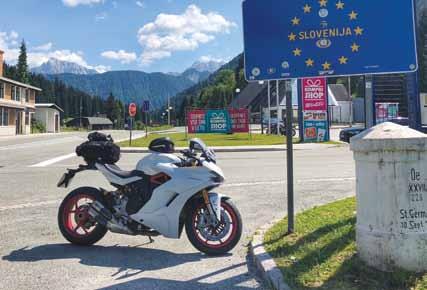
12 minute read
Howard Anderson
MY LIFE WITH BIkES
HoWaRd andeRSon
Advertisement
BMF’s Finance Director started riding aged 12... now supports son Shaun’s racing

“M y mum and dad didn’t drive, and I had my first bike, a James Captain, when I was 12. I didn’t publicise that at home as my father was the local JP... “Bikes were cheap back then in the 1960s, early ‘70s, and you could pick them up, including the old British stuff, for very little money. One lovely thing I had was an 80cc Suzuki with a four-speed box, high pipe, a grand wee thing. We thrashed that around the fields until it stopped – lack of
Photography: Philip Macgowan
oil I think. My first 100% legal bike was a CB125 Honda in around ‘72 when I passed my test. The test was so easy then, just ride around the block and put your arm out if you were turning right or left. For the emergency stop the examiner would step out in front of you. As long as you stayed upright and could answer a couple of questions on the Highway Code you passed.
“Once I passed I bought a Norton Dominator 88 with a Wideline frame and straighthrough megas, so you could hear me coming from four miles away! I didn’t use it for big trips, just going to work and back, riding around the countryside and down to the coast on a Sunday. I didn’t know much about bikes then because nobody in the house had a mechanical background, so everything I’ve learnt has been self-taught. Things like the ignition timing on the James, I learnt by doing. I didn’t own a car for a long time, and only learnt to drive because I was working for Post Office Telephones as an engineer.
“I’ve had lots of bikes over the years. I’ve always liked different things – I had a CZ once – but really anything with two wheels and an engine, I must have owned 100 bikes over the years. Odd things, like a Raleigh Wisp. I did do the Joey

Left main: Catching air at Holly Lodge (Photo: Peter Faragher) Left inset: Brief pause while running in the GSX-R1000 Above: On the Kramer, ready to go Above right: Shaun’s fiancée Sarah also races Right: Classic TT, 2016
memorial run to Estonia and back in 2001, that was on a big KLR, but I personally have never owned anything with more two cylinders. I’ve always been a believer in bikes which are light and as simple as possible.
“When I first met my wife Sheelagh I had a Yamaha DT400, which was great for sliding through roundabouts. But it didn’t really have enough go in it for big road miles so I bought a brand new RD400E – £768, that was. It went well but I remember the front brake was rubbish in the wet until it warmed up. I was riding about 40,000 miles a year, partly because I was working in Derry and Sheelagh lived on the coast. Sometimes I’d nip off and see her for an hour or so after work, and that was 120 miles each way. I had to keep on top of maintenance and would clean the chain and boil it in grease every 1000 miles – my RD was still on its original chain at 40,000.
“We got married in 1979 and still used the RD as transport – I can remember coming back from Dublin two-up, Sheelagh on the back with the shopping tucked under her arms. Then the kids came!”
Working with Ray
“I was getting involved in racing by this time. I used to help out Raymond Hanna, who was the last Irish 200cc Champion. I was basically his mechanic, but the facilities could be basic and sometimes we had to make do. I remember once racing in Formula 2 on the Island, using an RD350. We were trying to fit reed blocks in the back of a wee butcher’s shop on the Derby road. My job was to hold the barrel while Ray used a Black & Decker drill, taking the inlet port out before we finished it with emery paper. In the race, the chain jumped off at one point, but he went out again and finished 24th or 25th.
“We actually made our own monoshock frame for the RD200, but the class was changing to more race bikes so we moved on to a TZ125. We stroked that for more capacity and won the 200 championships in 1998 and ‘99. Unfortunately Ray lost his life in 2000 and the bike was going to be broken


up for parts, but I managed to save it and still have it in the garage. Ray’s daughters gave me the F2 race bike, and that’s a restoration project. It’s nice to have them because I have a lot of good memories of Raymond.”
Supporting Shaun
“When Raymond died, I swore I would never go back to the Isle of Man, and I didn’t get involved in racing again until my son Shaun started. He was helping out a couple of guys and was telling them how to set up the suspension one day when one of them turned round and said, “What do you know, you don’t even race!” On the way home, he decided to go racing, and bought a 600. The trouble is, he’s quite a big lad for a wee supersports, over six foot and 19 stone back then – other racers used to say he had the best slipstream around!
“He got into the 1000cc bikes at a Bishopscourt race in late 2008. A guy from my wife’s family was there and had a GSX-R1000, but couldn’t afford to race it because his wife was about to give birth. He offered it to Shaun, who was at the front of the pack in his first 1000 race. Once he got the taste, he had to have one, so he bought one and we started racing it in 2009.
“He started the season with a double win at Bishopscourt and went on to win the Ulster Championship. The only problem was that to stay on short circuits we would have been automatically moved up to race with the big boys, which would have meant having to buy a proper superbike to be competitive – something with a real budget, where this bike only cost about £3500. So for 2010 we started doing the closed roads races. That worked well and Shaun was on the podium in all three or four races we took part in.
“He wanted to do the Manx as well, so we saved up and he bought a stock 750 Suzuki, because you couldn’t start out with a 1000. He finished second in the Newcomers race on that, which was good, and also received a replica in the 600 class. He was due to start 70th in the Senior support race but because of the speed which he had done during the week they put him up to 17th. He finished fifth overall and was fastest Newcomer over the week at about 118mph.”
Few Fears
“I didn’t really have much trepidation about Shaun racing because he wasn’t a 17-year-old. He’d been on a bike since he was three and on the road legally at sixteen – his first road bike had a seven-port barrel, so he was used to performance. At seventeen he passed his test but we also made sure he did his BMF Blue Riband, and when he finally started racing he was 25, so he knew what he was about. He’d also been in hospital enough to know that it hurts when you fall off!
“Actually, my wife and I were happier with him racing than we would have been if he was just on the road. Racing took away that need for speeding on the road, and he would just use his old van for getting to work. Racing is also safer in some ways – fall off during a race and you have the best medical attention within a couple of minutes, but if anything happens on the country roads around here, it could be hours before someone finds you.
“If there’s a red flag incident on the Isle of Man, your first thought is, where is your rider, could it have been him? If you work out that your rider wasn’t close enough to have been involved, then you relax. I remember when Daley Mathison tragically died in 2019 just before Union Mills – Shaun was only a few seconds behind him when it all went wrong. They stopped the race after that and when Shaun came in he was shaking. But when they restarted he went out again. “You never know what’s going to happen on the Island. Obviously Shaun was Fastest Newcomer in his first Manx Senior and had all the accolades but then the following year was terrible. Silly things went wrong. In the 600 race he came in for fuel and the bike wouldn’t restart – the battery had boiled itself. In the Senior there was only a split second between Shaun and Andrew Brady who went on to win it, but the bike developed a misfire. The whole thing was a disaster for us but that’s what the Isle of Man can do – sometimes things go right, sometimes nothing does.”
The TT
“The Manx costs a lot of money to do and in the end Shaun decided to move on and concentrate on the road races. He was actually offered someone else’s bikes for the following Manx, but his attitude was, if he was fastest in practice, he would have nothing to

Left: “He’s a big lad, the best slipstream around” Above: GSX-R1000 is still competitive
aim at. He wanted to follow guys who were faster than him, so that he could learn from them.
“So in 2012 we moved to the TT – he did a 124mph lap in one race and reckoned with a bit of tweaking on the suspension he could crack 125mph in the Senior...then for the first time, they cancelled it. He had an ex-Cameron Donald 1000cc Suzuki, and we did a lot to that bike, fitted higher compression pistons, fancy cams, upgraded the brakes – it was producing about 197bhp. The trouble was it was a continual effort to keep up, with more electronics going onto the bikes, though ours was one of the last without ABS or traction control. We were finishing in the top 20, which considering we had no major backers wasn’t bad. We just kept chipping way.
“In 2016 we were running in the top 12 when he had a bit of a scuffle with Davey Morgan – Davey’s rear tyre spat up a stone which went straight through our radiator, so he had to retire on the last lap. We bought a new bike for 2017 which arrived late, and my first job was to put 1000 miles on it on the road before taking off the exhaust and some of the electronics. It was still basically a road bike when he took it to the line at Tandragee 100 – that’s like a mini TT, with lots of humps and jumps, very different to a smooth short circuit. He’d only just flown in from Austria, as he was working for KTM by this time. There was a problem in practice and he qualified 22nd, but in the race climbed back up to seventh.
“We also had a Kramer for that event. These are built by Marcus Kramer in Germany and use an engine based on the KTM 690, with the fuel tank under the seat. It’s a good bike, which has won the the European Supermono Championship. Shaun qualified second on that, but unfortunately another rider was killed and that race was abandoned. It might have been just as well as the fabricated swinging arm had developed a couple of hot spots. It would have been fine on the short circuits, but they don’t have the humps and bumps which our roads do. “It was that which spurred us to work with Marcus Kramer to develop a cast swinging arm for the bike. To me, race development never stops – just because you’ve done well one year doesn’t mean to say you don’t have to improve for next year. “In 2019 we were finally seeded, but the problem was that increasingly the organisers wanted big-budget teams arriving in trucks. They didn’t want a couple of guys to turn up in a rusty HiAce van with the bike in the back. Being seeded did help though, and Shaun was offered a ride on the Williamson BMW that year. He now works for KTM in Germany and lives with his fiancée Sarah Boyes – Sarah also races the Manx and was top female in 2019. They both come back to race here.
“2020 was a total wash out. Shaun did manage to do a couple of short circuit races before lockdown, getting a second at Brno on the Kramer. He was only doing it to keep his hand in. Mind you, he often says that, ‘I’m just using this race as a run around.’ OK, I say, so how come you’re so close to the lap record? When you have that race instinct in your head, that’s just how it is.
We’d love to race this year if it’s possible. It was quite a blow when the Tandragee 100 was cancelled, but the bike is ready and, yes, we’d love to race.”
BMF & Others
“I joined the BMF in the late 1970s and became assistant for the Northern Ireland region before becoming chair here – I still am, as well as Finance Director for the BMF nationally. I’m Chair of Rathfriland MCC, we do mostly charity work on a local basis for people and animals. Also President of the Tandragee 100 Supporters Club. as it’s our local event and we’re currently working on a way of getting that going again, but the insurance alone for a national road race is very high now – add all the costs up, and a typical national road race costs about £100,000 to put on. One thing we wanted to do this year is commemorate the Banbridge 50, which was held in 1921 and was Stanley Woods’ first race. We’re planning an event in July to mark the 100th anniversary, so as usual I’ll be cajoling my friends to take part – it’ll be nice to have something to brighten the year up.”


